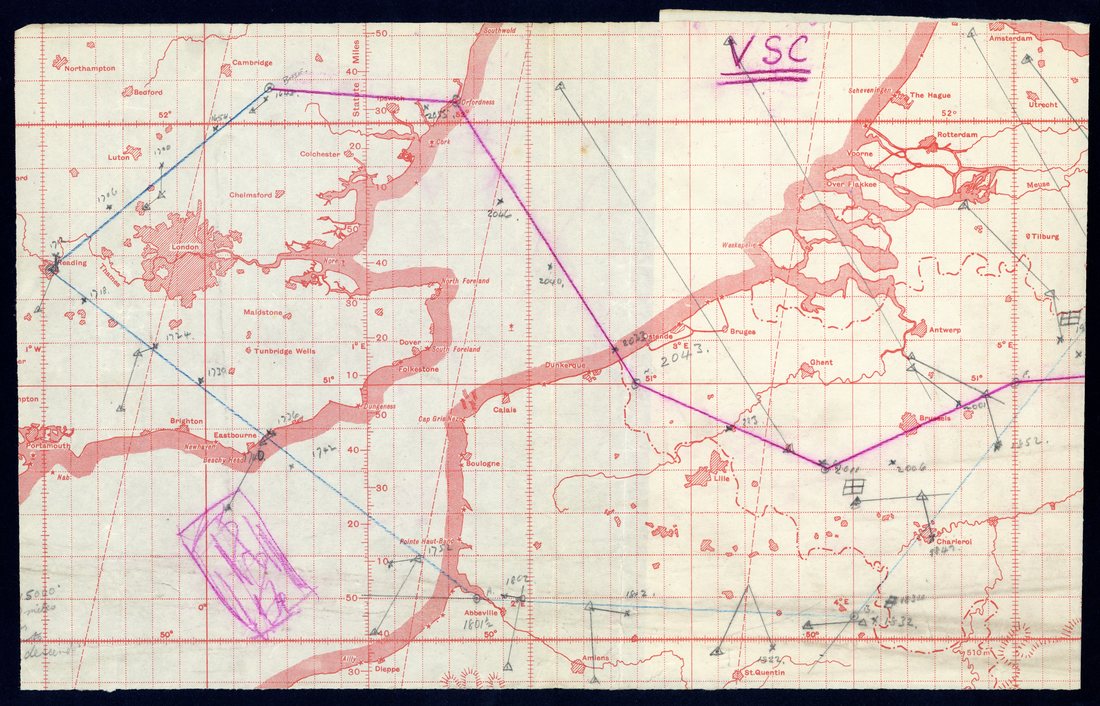
Auction: 16043 - Autographs, Historical Documents, Ephemera and Postal History
Lot: 101
Documents
Number 3 Group, Bomber Command
1944 (November) to 1945 (March) navigation logs of Sgt. Barrett, each sortie includes his flying log (completed in pencil) and route map printed in red.
The first log is with 514 Squadron (R.A.F. Waterbeach) dated 1944 (30 November), flying H2 with orders to "release P on Rheims" with debriefing instructions from his c.o.
1945 (8 January) log and map for the raid on Duisberg, again with his c.o's debriefing notes.
1945 (13 January) now with 195 Squadron at Wratting Common; a daylight raid of Saarbrucken, the c.o's notes are now more complimentary, "You had a good trip, . You made plenty of ETA checks" - 158 Lancasters of No 3 Group attacked the railway yards at Saarbrücken. The bombing appeared to be accurate, though with some overshooting. 1 Lancaster crashed in France.
1945 (4 February) night time raid on Dortmund which includes the note "Bombs gone" at 19.31. 149 Lancasters of No 3 Group attacked the Hansa benzol plant at Dortmund but the bombing fell north and north-west of the target. 4 Lancasters lost.
1945 (7 February) daylight raid on Wanne-Eickel where 74 Lancasters bombed the oil refinery in the wintry conditions which had scattered the force.
1945 (13-14 February) the night time raid on Dresden (no chart map) including the note "Bombs gone" at 01.21
1945 (14 February) night time raid on Chemnitz, at one point on the return the log records "large fires 20 miles to port" which could refer to Strasbourg. 499 Lancasters and 218 Halifaxes of Nos 1, 3,4,6 and 8 Groups to continue Operation Thunderclap. 8 Lancasters and 5 Halifaxes lost. This raid took place in two phases, 3 hours apart. A very elaborate diversion plan succeeded in keeping bomber casualties down but Chemnitz - now called Karl-Marx-Stadt - was also spared from the worst effects of its first major RAF raid. Both parts of the bomber force found the target area covered by cloud and only skymarking could be employed. Post-raid reconnaissance showed that many parts of the city were hit but that most of the bombing was in open country.
1945 (19 February) daylight raid on Wesel. Wesel became a target of the Allies, particularly in its strategic position as a depot with bridges on the Rhine. On the 16, 17, 18 and 19 February 1945, the town was attacked by the British Royal Air Force with impact and air-burst weapons and almost entirely destroyed.
1945 (22 and 28 February) daylight raids on Gelsenkirchen oil refinery, the second without chart but where 156 Lancasters bombed Nordstern using G-H.
1945 (25 February) daylight raid on Kamen when 153 No. 3 Group RAF Lancasters carried out a G-H attack on the synthetic-oil refinery.
1945 (26 February) daylight raid on Dortmund (no chart) as part of 149 Lancasters bombed the "Hoesch-Benzin GmbH benzol-oil plant" using G-H.
1945 (9 March) daylight raid on Datteln but without chart. 159 Lancasters of No 3 Group bombed the North and South plants of the Emscher Lippe benzol plant near Datteln. The target area was cloud-covered and G-H was used. The bombing appeared to be accurate but no results were seen. 1 Lancaster lost.
Plus some other logs including either training or cancelled flights completing a remarkable record. Photo
The closing months of the war saw arguably the most controversial operations, such as the raid on Dresden in February 1945.
In four huge raids by the RAF and United States Army Air Force, a firestorm destroyed the city centre and killed thousands of civilians.
The planners of the raid argued the city was a vital communications hub and needed to be targeted.
The critics said that Germany was well beaten and the bombing was needless.
The truth is that it was a time of total war, and ideas about the boundaries of conflict were very different than those we have today.
G-H Gee, sometimes written GEE, was the code name given to a radio navigation system used by the Royal Air Force during World War II. It measured the time delay between two radio signals to produce a "fix", with accuracy on the order of a few hundred meters at ranges up to about 350 miles (560 km). It was the first hyperbolic navigation system to be used operationally, entering service with RAF Bomber Command in 1942.
Subject to 20% VAT on Buyer’s Premium. For more information please view Terms and Conditions for Buyers.
Estimate
£4,000 to £5,000




